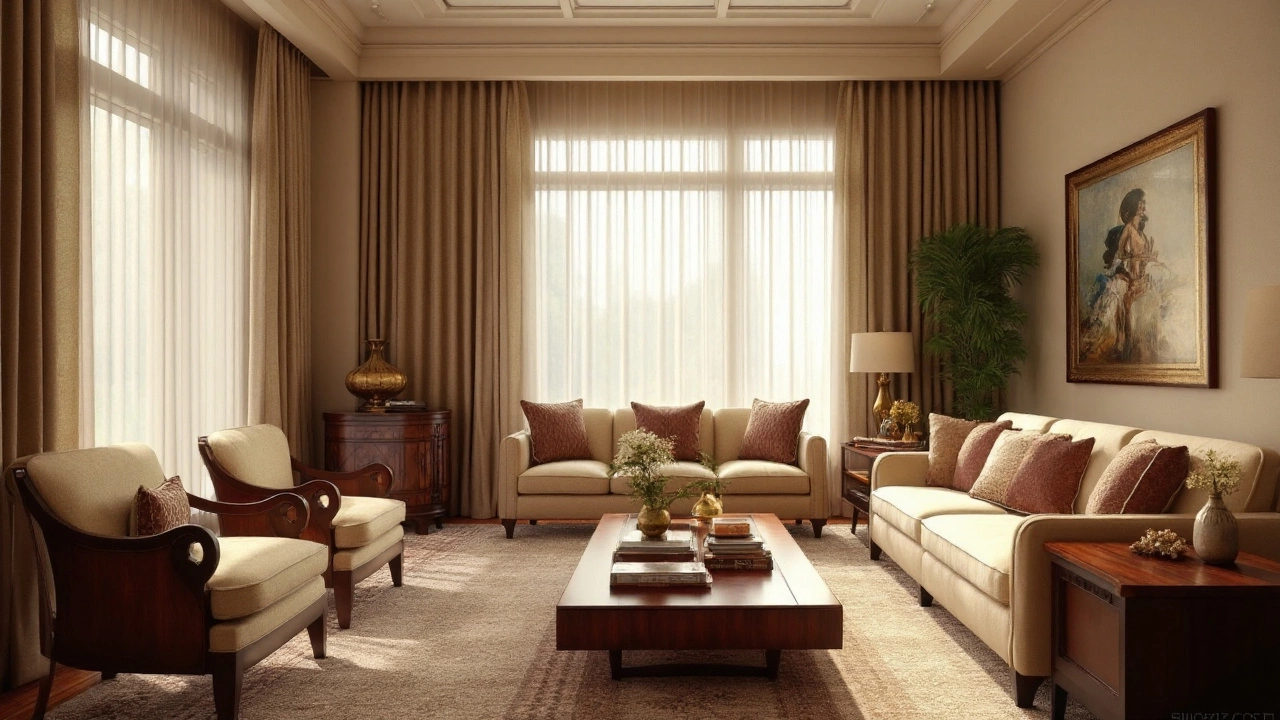Ever walked into a friend’s living room and thought, “Whoa, is this stuff expensive—or just pretending to be?” That’s the vibe a lot of folks get when they see an Ethan Allen sofa for the first time. There’s polished wood, tailored fabrics, and a price tag that doesn’t play coy. But hold on—does that make Ethan Allen truly high-end, or is it just hitting that sweet spot between fancy and sense-making? I’ve spent hours digging through catalogs, customer reviews, and even insider interviews to answer the question. Ready for a straight-talk journey through style, status, and dollars? Buckle up because Ethan Allen’s story is more layered than their eight-way hand-tied springs.
What Makes a Furniture Brand ‘High-End’?
Let’s start by cutting through the marketing buzz. The term ‘high-end’ gets slapped on everything from headphones to canned tuna these days, but when it comes to furniture, what are we really talking about? The heart of it is a short checklist: top-shelf materials, real craftsmanship, consistent design, and a price tag that says, “I dare you.” High-end usually means comfort that lasts a decade (not just a season), finishes that survive kids and parties, and a look that feels pulled from a magazine—without being trendy-for-a-week.
For example, a true luxury couch won’t sag after two years, and the hand-stitched seams will run straight. Brands like Restoration Hardware, Baker, and Hickory Chair land firmly in this camp. These companies tend to use hardwood frames (think kiln-dried maple or oak), hand-tied springs, and natural textiles. They’ll have custom finishing, maybe even hand-applied stains or distressing. Salespeople know the backstory for every fabric and wood. Of course, you’re also paying for that story—the heritage and the promise that no neighbor will have the same exact piece unless they’re copying your taste.
There’s also the matter of service. High-end brands tend to offer white glove delivery, personal design consultations, and generous warranties. Mess up your order? They’ll bend over backward to make it right. Feeling left out of the process? They’ll walk you through every step, sometimes even inviting you into their factory for a closer look. These are the details that separate the premium brands from the crowd, and they’re what buyers expect when they hear the term ‘high-end.’
So, does Ethan Allen check these boxes? Hold that thought—let’s dig into their history because the origin story here is a big clue.
The Story Behind Ethan Allen: From Americana to Aspirational
Ethan Allen got its start way back in 1932 during the Great Depression, and the name itself is a shoutout to the Revolutionary War hero famous in Vermont. Unlike newer brands, Ethan Allen leaned hard into American heritage right from the start—timeless designs, solid craftsmanship, and a sense that your furniture should outlast trends and maybe even outlast you. Over the decades, they turned that old-school American style into a signature look: wingback chairs, cherry wood cabinets, and beds that wouldn’t look out of place in a cozy New England inn.
Fast-forward to the present, and Ethan Allen is still privately owned. While more brands keep moving their manufacturing offshore to save a buck, Ethan Allen sticks to its roots: about 75% of its furniture is crafted in North America, mostly in U.S. plants. That’s rare these days and something they don’t hesitate to brag about. This not only lets them keep a closer eye on quality but also appeal to buyers who care about American-made goods.
But it’s not all tradition. Over the past couple of decades, Ethan Allen did a massive style pivot. They mixed in more modern collections—sleek leather sofas, minimalist beds, cool glass-topped tables—without dumping the classics. The company also launched a custom program where you get to pick your own fabrics, finishes, and hardware. No more “one size fits all”—you get something tailored to your taste (and your living room’s weird corners).
The result? Ethan Allen appeals to both buyers who want a grandma’s parlor vibe and younger families looking for comfort with a side of polish. Their network is huge: over 250 stores across the U.S., Canada, and a handful internationally. It’s way more accessible than boutique luxury brands and way more personal than what you’ll find stacked in a warehouse store.

Ethan Allen’s Materials and Craftsmanship: Are They Actually Luxury?
If we’re talking about high-end, materials and craftsmanship are where pretenders get exposed. Ethan Allen claims their stuff is the real deal, but what’s the evidence? Walk into their showroom and you’ll notice: they use a lot of solid wood—maple, birch, cherry. No pressboard here, at least not in the major structural parts. Frames are often mortise-and-tenon joined (that’s woodworker-speak for joints that don’t give up easily). Cushions usually get filled with a mix of foam, feathers, and down, with options to upgrade if you like a firmer seat or more “sink-in” softness.
The upholstery is a big selling point. Ethan Allen offers hundreds of fabric and leather choices, most sourced from American and European mills. They’re not shy about letting you pick the texture and color, so no one else has to look at the same off-the-shelf sofa. The tailoring is tight, the seams don’t pucker, and you’ll find piping and button-tufting done by hand on their top-shelf pieces. Some seating uses eight-way hand-tied springs—a technique prized by furniture snobs because it keeps you comfy for years.
Take the Ethan Allen “Arcata” sectional, for example. Built from kiln-dried hardwood and customizable in size and fabric, it’s a direct shot at high-end shoppers. Their solid wood dining tables usually feature a catalyzed lacquer finish, so wine spills and spaghetti sauce are less of a nightmare. Drawers run smoothly because they’re mounted on wood glides, not cheap tracks. Even lighting and rugs in their collection are well-made, often favoring wool over synthetics or hand-knotted construction.
Still, you’ll notice that Ethan Allen uses veneers in some pieces, especially where it makes sense for design and stability (long tabletops, for instance). This isn’t a cheat. Quality veneers done right last a lifetime and let the company offer gorgeous grains while using less rare wood—good for the earth and your wallet.
| Ethan Allen Product | Frame Material | Cushion Fill Options | Key Feature |
|---|---|---|---|
| Marlowe Sofa | Kiln-dried hardwood | Foam/down blend | Custom fabrics available |
| Arcata Sectional | Maple/birch hardwood | Support core with feather/down topper | Eight-way hand-tied springs |
| Preston Dining Table | Solid cherry/veneered top | N/A | Catalyzed lacquer finish (spill-resistant) |
If you need the proverbial cherry on top, Ethan Allen ships most furniture fully assembled. You won’t have to wrestle with an Allen key for three hours or worry about wobbly legs.
Price and Value: How Does Ethan Allen Stack Up?
People often say, "You get what you pay for," but is Ethan Allen charging you for quality or just for a name? Here’s how their numbers look against the competition. A standard Ethan Allen sofa usually runs from $2,000 to $4,000, depending on size, fabric choice, and customization. Custom sectionals? You could touch $7,000 or more. Dining tables usually hover around $1,500 to $4,000, with chairs about $350 a pop. Bedroom sets, if you go all out, can hit $8,000 or higher. Not easy on the wallet, but these are pieces meant to outlast three Netflix series and a couple of family pets.
Compare this with Restoration Hardware (where sofas start around $4,500 and quickly climb past $10,000) or Pottery Barn (where mid-tier models go for $1,500–$3,000). Ethan Allen doesn’t aim for bargain shoppers. But it doesn’t stomp all over “luxury for show-off’s sake” territory, either. Their selling point is investment furniture—stuff that looks sharp and is built for daily life with real humans.
Don’t expect big holiday blowouts or wild price drops. Ethan Allen runs sales, but usually in the 10-20% range, and they’re straightforward about it. You’re much more likely to find a free design service than a massive markdown. They know their customer: someone who wants to feel good about where the money’s going, both in materials and in story.
- If you’re hunting pure value per dollar and you don’t mind assembling a bookshelf, IKEA or Wayfair will crush any high-end brand on price—but not on durability.
- If luxury means “can brag to my in-laws that it’s Italian,” you’re likely looking for B&B Italia or Roche Bobois, not Ethan Allen.
- If you want classic style, customization, and heirloom vibes without taking out a second mortgage, Ethan Allen is a legit option—especially if you live in, or near, places where their design support is free and local delivery is fast.
The sweet spot for Ethan Allen is families who want comfort, staying power, and stylish options, but not at prices that make you sweat every time someone sets a drink on the table. This is furniture you keep and hand down, not stuff you haul to the curb when you change apartments.

Reputation, Service, and Real-World Experiences
Let’s step away from glossy ads and talk about what folks say after living with Ethan Allen furniture. Reviews are mostly strong—buyers rave about the comfort and looks. Support often gets a thumbs-up, too: Ethan Allen offers personal design advice at no charge. That means you can walk into a store (or set up a virtual session) and get a pro to help, whether you’re decorating one room or your entire house.
White glove delivery is another plus. The delivery crew does more than just plop boxes on your porch—they assemble, carry in, clean up, and haul off the packaging. If you’re accustomed to getting dumped with a pile of boxes and a “good luck,” this feels next-level. Customers often mention how seamless the process is, from consultation to set-up.
Customer service isn’t always perfect—if there’s a complaint, it’s usually about lead times. Since much of the furniture is made to order, you might wait 8 to 12 weeks for certain items. That’s par for the course with high-end brands and not a sign of trouble, but it’s something to know before you order. On the upside, Ethan Allen has a solid track record of addressing issues, like handling damaged goods promptly or fixing minor upholstery problems.
Another thing: the company has leaned into sustainability. They’ve cut down on waste, use low-VOC finishes, and have a recycling program for old furniture. Not every high-end brand bothers, but buyers increasingly care about how and where products are made.
Here’s a little tip: if you want to stretch your budget, check out Ethan Allen’s clearance or "floor model" programs. You can score big discounts on display items that are gently handled. The warranty still applies and the customer support stands behind it. This way, you skip the long production wait and walk away with the good stuff for a lot less. Buyers also mention the "pre-owned" resale market for Ethan Allen is surprisingly strong, so if you ever want to swap styles, you won’t have trouble finding buyers.
Fancy lure aside, the real Ethan Allen test is how the furniture looks—and feels—after five or even ten years. Most owners say it stands up to kids, pets, spills, and style trends. Even after a decade, their classics hold value and keep looking smart. If bang-for-buck peace of mind matters, that’s a solid reason to put Ethan Allen on your shortlist.

